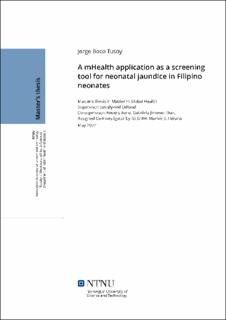| dc.description.abstract | Abstract
Background: NNJ is still considered a global health burden, with around 80% of preterm and 60% of full-term newborns most likely to develop jaundice. These cases are alarming as 10% of the affected newborn will most likely progress to high bilirubin levels, which can cause brain damage and other neurological disabilities. Data suggested that there is a need for a non-invasive and affordable screening tool for NJJ, particularly in LMICs.
Objective: To assess the performance and accuracy of the mHealth application as a screening tool for neonatal jaundice among Filipino neonates.
Methods: Newborns ≥ 37 weeks gestation with or with clinical jaundice were included in the study. All less than 2500 grams, who had undergone phototherapy, and newborns with congenital abnormalities were excluded. Only newborns past 24 hours to 14 days of life were included. The correlation between mHealth and Kramer scale, TcB, and TSB was identified. In addition, a Bland Altman plot was performed to determine the agreement between the two tools. The accuracy of the innovation can help reduce disability cases related to neonatal jaundice. Furthermore, the sensitivity, specificity, and positive and negative predictive values were calculated for the App, TcB, and Kramer scale.
Result: Our finding revealed a positive moderate correlation between the that mHealth Application and the Kramer scale, 0.625 (95% CI 0.46-0.75, p <0.01), TcB, 0.608 (95% CI 0.43-0.74, p <0.01) and TSB 0.666 (95% CI 0.51-0.78, p <0.01). At the TSB cut off values of 200 umol/L. Sensitivity, Specificity, Positive Predictive Value(PPV), and Negative Predictive Value (NPV) of the mHealth application values shows 55.6, 90.0, 45.5 and 93.1 respectively. At 250 cut-off for TSB and mHealth application the Sensitivity and Specificity, 50.0% ,94.0% respectively.
Conclusion: Our findings revealed that the mHealth application could accurately detect neonatal jaundice by estimating the bilirubin level among Filipino neonates. It can be used as a screening tool to detect jaundice but not a confirmatory test. A high estimation result by the mHealth application signifies a blood test. Besides TSB is still the gold standard to confirm the bilirubin level of the neonates. | |
